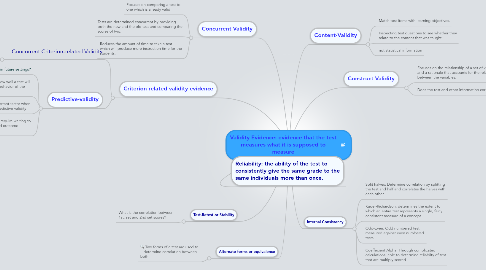Validity Evidence: evidence that the test measures what it is supposed to measure
por Andrea Nichols

1. Criterion related validity evidence
1.1. Concurrent Criterion-related Validity
1.1.1. Determined by correlating test scores with a criterion measure collected at the sametime
1.2. Predictive-validity
1.2.1. How will students perform in future settings?
1.2.2. Concentrates on how well a test will predict a specific behavior of the future
1.2.3. Time is an important factor when determining predictive validity
1.2.4. Predictive test require waiting to see if predicted outcome happens
2. Test-Retest or Stability
2.1. What is the correlation between 1st. set and 2nd set scores?
3. Alternate forms or equivalence
3.1. Two forms of a test are used to determine correlation between both.
4. Concurrent Validity
4.1. Focuses on comparing a test to one which is already valid
4.2. Tests are determined concurrent by providing both the new and the old test and comparing the scores of two.
4.3. Reduces the amount of time to take a test which will produce more instruction time for the students.
5. Reliability: the ability of the test to consistently give the same grade to the same individuals more than once.
6. Internal Consistency
6.1. Split halves: Determine correlation by splitting the test and half and correlates the halves with each other.
6.2. Kuder-Richardson: determines the extent to which an entire test represents a single, fairly consistent measure of a concept
6.3. Odd-Even: Odd numbered test measured against even numbered tests
6.4. Coeffecient Alpha: Through complicated calculations, able to determine reliabilty of test that are multiply scored
7. Content-Validity
7.1. Match test items with learning objectives.
7.2. Inspecting test questions to see whether they relate to the content that was taught.
7.3. not statistical information
8. Construct Validity
8.1. Focuses on the relationship of a set of variables and a rationale that accounts for the relationship between the variables.
8.2. Does the test and other information correspond with a theory?


